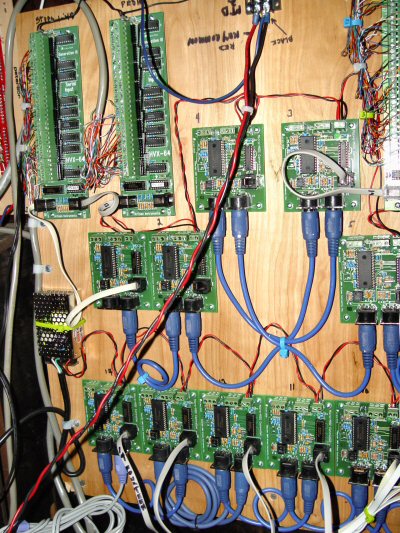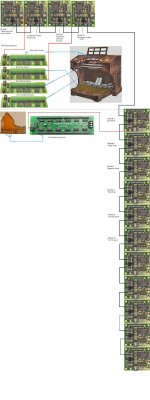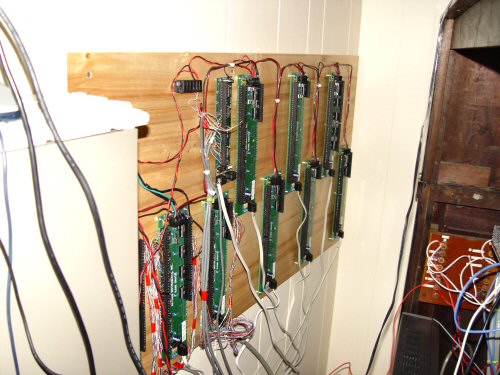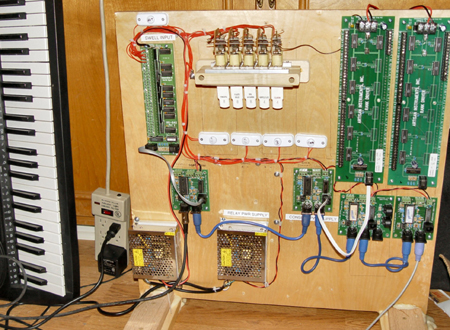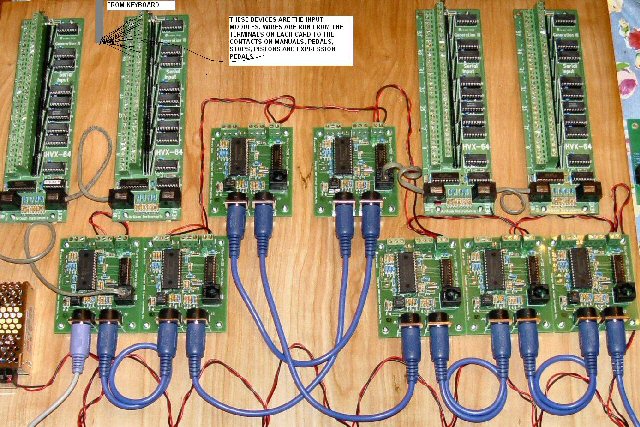
MY OTHER
WEB SITES:
RECOMMENDED LINKS
CONSTRUCTING A MODERN THEATRE ORGAN RELAY |
This section of my site is a serious discussion of the organ's relay system. In selecting a relay to replace my original failed electro-pneumatic relay, I first seriously considered whether I should rebuild an electro-pneumatic relay, I made the decision to go with a computerized relay for several reasons. First, an electronic relay provides an easy way to set and modify the combination action, plus it makes available different levels of memory if the organ is to be used in concert. While the old relays still have a lot to offer, modern artistry is almost demanding the features that come with electronic relays. Since my Wurlitzer is small by comparison, I did not want to limit its functionality to anyone who plays it. Secondly, electronics makes it easy to add ranks and features to the organ. Since my organ has always been a "work in progress", the thought of being able to add a toy, tuned percussion, or even another rank of pipes on a whim, seemed very attractive. In selecting a brand of relay, I will say that there are many good relays out there. I have used Peterson relays on a number of my restorations, and I have played organs that used several other recognized systems as well. My initial decision to go with Artisan centered on the fact that their newest product line is a modular system where individual components can be purchased separately and incorporated at any time to expand the relay and the instrument. This is especially good news for hobbyists who may wish to spread the cost out over an extended period of time, or who are designing their instrument as they go or as parts become available. The people at Artisan have been excellent to work with. I have had technical questions answered promptly, even at 8 pm on a Sunday evening in one case, and the company stands behind their products 100%. While I must acknowledge that there are other very good relay providers and support structures for their products, I am sold on Artisan and the way they do business.
The photo above shows the console end of the Artisan system used on my residence Wurlitzer. Each of the modules shown can be purchased separately. A total system can be built as you go, and all components do not have to be purchased at the onset of the project. In addition to the console board, there is a second board located in the pipe chamber. It holds the pipe driver components needed to interface with the pipe chest valves, percussions and toys. The Artisan requires that the user write a simple set of commands to fit the operation of their individual system. This "program" is written in simple English syntax called Object Oriented Programming. In other words, hexadecimal code, machine language, and the other things that plague computer programmers do not come into play here usually. Instead, the user simply names a device to be controlled (like a manual, stop or rank of pipes) and then tells the relay how to deal with that particular component. Artisan has produced an excellent, easy to understand manual to guide even the most computer-illiterate user on how to set up a system. To serve as a guide to other users, I have placed a copy of my organ's relay program HERE. The diagram below shows the components that I used to design my system. Click on the picture below to see a larger view. |
Above: the chamber components of the relay. |
OTHER USES OF THE ARTISAN UMIDI SYSTEM |
While this does not pertain specifically to my organ installation, I have added a section here to discuss the potential use of this same relay system by persons who wish to build "virtual" organs, or by users of existing electronic organs who may wish to expand their instruments through the use of MIDI features that the Artisan provides. One case that comes to mind involves a friend who wanted a practice organ for his home. Not wanting to spend upwards of $80,000 for a digital electronic organ by a leading manufacturer, he opted for my "Plan B", which provided him all the features of a home pipe organ, for about $2000 in material. His project was spawned by the availability of a discarded church organ console that was in fairly good condition. The church had decided to expand the organ and therefore needed a larger console. He was able to pick up the old console after it became a storage problem for the church. The first item of business was moving it to his house and cleaning it up. All of the old cotton-covered wiring was replaced with new thermoplastic wire. We then began installing Artisan components to "midify" the manuals, stops and pedals. The sound generation for this organ is a medium range personal computer that runs the free program called Miditzer. Miditzer was developed by Jim Henry and it is software that emulates a Wurlitzer pipe organ on a computer screen. The sounds produced by this software are actual high-quality digital samples of a real theatre organ. In my opinion, they are of a quality that will give the major manufacturers of electronic organs a run for their money, plus the user can further tweak or substitute the samples to his or her liking by editing them with readily available free software from the Internet. While we used Miditzer for this project because it is free, there are other similar software packages, both free and for a fee, that do equally well. Two that come to mind are Jorgan and Hauptwerk. You can learn more about these packages by Googling the product names or by searching "virtual organs" on the web. Because of the availability of relatively inexpensive means to obtain virtual organs, all across the United States and the world, user groups are evolving for the support and development of these products. Where home organs had been declining since the heyday of the 1950's, mostly due to the cost of consumer electronics and the expense of developing or purchasing factory made digital organs, there is a new resurgence in home organ projects and hobby organists because of these easy to use and inexpensive solutions. In the case of my friend and his discarded church console organ, we were able to provide him with an organ that looked, felt and sounded like a pipe organ. He can now practice and enjoy his music in the comfort of his own home, and what he has invested would barely purchase the bench from one of the leading factory made name-brand organs. ADDING PIPES: Like most organ hobbyists, my friend is always looking for a deal in surplus organ parts. He was recently able to obtain the pipes, chest and winding system from a three-rank Moller Artiste pipe organ. We found that it was a relatively easy assignment to make the Artiste play from his virtual organ console. All that was required was about $500 of additional relay modules, so he now has a serious electronic organ and a small pipe organ, and the project still has not exceeded $3000. |
The photo above is a demonstration / educational unit that I designed and built to teach others how simple it is to work with modular organ relays. I am taking this demo around to local technical schools and to meetings of organists and organ hobbyists. I can also use this device to test programs that I intend to use on my organ and the projects with which I am helping others. I will soon be releasing a YouTube video covering how to build a virtual organ, and there are also some excellent YouTube videos by Mark Anderson, of the Artisan Company, detailing the application and use of these products. If you are interested in more information on these products, please contact me and I will be happy to share what I have learned through my own experiences. |
| THE TECHNICAL DISCUSSION OF RELAYS |
Despite the many brands and technologies applied to modern pipe organ relays, the concept can be easily understood if we think of a relay as a telephone switch serving a small city. Whether the relay uses standard Midi calls or proprietary software and language, the end result is the same. Each key, piston, swell pedal, and actuation control on the console represents a caller into the telephone system. Each pipe, trap, combination memory slot, and swell opening represents a user with a phone that can receive phone calls. The relay's processor and software handle the switching function of making sure that an incoming call is identified and channeled to the correct recipient. Under normal circumstances, organ keys and other signaling devices are ultimately electrical switches or momentary contacts that allow electricity to flow whenever the organist touches them. The relay software or firmware assigns a unique address to each input and output device on the system. If a key is depressed for example, an address in the processor is activated. The software then sees that as a request and a logical sequence of steps is followed according to what has been programmed. For the sake of explaining this sequence of events, let's say that middle C is pressed on the swell manual. The relay recognizes this by the numerical input that is generated because of voltage flowing at the input point to the relay. At the same time, the organist may have activated the 8' flute stop in the Swell division, so that also shows up as a separate input request at the processor. The software compares the fact that the key is being pushed and the specific stop is activated, and the logic routine tells the system that the 8' flute middle C pipe must be played. The system therefore sends a signal to the transistor or solid-state device that controls the flow of current to that valve magnet. The transistor begins to conduct electricity and the valve is opened and the pipe is sounded. If multiple stops are on, or if traps are desired along with notes, the relay's program recognizes this and sends "play" commands to multiple pipes or devices as indicated by the program and by the organist's commands from the console. In the same way that the telephone switch knows that a number in or outside of the system is calling Mrs. Jones at 496-259-4700, the relay knows that a call is coming in for a certain note or sequence of notes, and the signal is sent to those devices causing them to play. Let's take a look at the specific devices that to together to make up the relay hardware. This may differ slightly from one manufacturer to another, but the concept is the same. INPUT DEVICE:(Click for larger view) The input devices for this organ relay are the four rectangular computer cards located across the top from left to right. Each of these cards allows sixty-four individual input points, and two or three cards can be placed in tandem on one processor. The processor cards are the shorter cards with the blue inter-connecting cable. On this relay, the input card to the left processes the stop switch inputs. The second card processes the pedal key inputs and the pistons, swell pedals and toe studs. The two cards to the right process the great and swell manuals of this two-manual, six rank theatre organ. Each pair of input cards connect to a corresponding processor board. The extra processor boards shown serve specific purposes such and manual-manual couplers and processing for output devices such as the pipe driver cards. In this case input and output parts of the relay were grouped together to save space. This relay, which was assembled from modular components made by The Artisan Instruments firm, utilizes Midi technology to talk back and forth between the components of the organ. At the point where all four inputs are connected, a signal will be present at the midi jack of that module that will contain all of the input information for the entire organ. That signal can be used to play pipes that are connected to additional relay modules, or it could be used to play some other midi instrument such as a sound synthesizer, a personal computer providing organ sounds through the use of sound fonts, or even a piano or midi equipped band instrument. A feature of the Artisan product is that the output is standard Midi and the user can easily mix and match this manufacturer's products with other standard Midi devices. |
JOHN'S ORGAN HOBBY GUIDES
Toy Counter projects:
Train Whistle
Cow Bell
Drums and cymbals
MY OTHER PROJECTS
